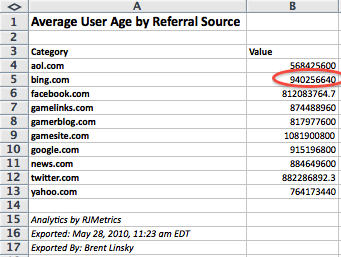Today, we’ll be taking a look at another RJMetrics analytical tool: dynamic age calculations. RJMetrics can calculate the “age” of any date stored in your system, providing helpful look at how much time has passed since a particular stored date. This can be useful in a number of situations, including:
- Studying the age of your user base (when their birth date or birth year is collected).
- Studying the amount of time since a particular event, such as a user’s first purchase or most recent subscription payment.
- Examining negative ages (the time until a future event), such as a graduation date or expiration date.
For this example, let’s take a look at the fictitious company Play Now (an online gaming site). We will build a chart by selecting the trend ‘Average User Age’ in step 1 of the chart builder, and then we’ll group the data by “referrer” in step 3. This results in the chart below:
As you can see, the average customer’s age varies significantly based on their referral source. Sites like aol.com are referring the youngest users, while the site “gamesite.com” is referring the oldest. This information could obviously be very helpful in combination with statistics like acquisition cost by channel and conversion rate by age. It could also be used by a marketing department to make sure the right messaging is used in each channel. Note that exporting the data behind this chart will result in a data set shown in seconds. This allows for the greatest possible granularity and can always be converted to other time units with some simple equations.
If you’re interested in learning more about RJMetrics, check out our website where you can learn more and try out a free demo.


